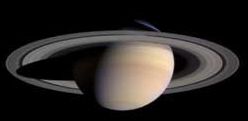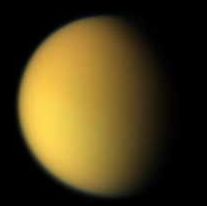



C A S S I N I is presently mid-way through its exploration of Saturn being the first totally dedicated interstellar mission to planet. Yhe mission is named after the 15th Century French-Italian Astronomer Jean Dominique Cassini (1625-1712), also known as Giovanni Dominico Cassini, who observed Saturn in much detail. He also discovered the four major moons of Dione, Rhea, Tethys, and the mysterious satellite of varing brightness, Iapetus.
One part of the craft is known as the Huygens Probe which is a component designed to explore Saturn’s largest moon, Titan. It was designed and developed by a number of European countries as a collaboration as the ESTEC Consortium. The probe honours the Dutch scientist, observer and skilful optician, Christiaan Huygens (1629-1695). He first discovered Titan in 1655, and in the same year, determined its sixteen day orbital period. Just as importantly, he found that Titan’s orbital path was in the same orientation as the observed ansae or handles. This lead to the partial deduction of the true nature of the rings.
The whole Cassini-Huygens spacecraft weighs more than two tonnes and carries twelve main specialised scientific experiments. It is one of the most advance spacecraft to visit anywhere in the outer Solar System so far. One of the major advances will be the images that will be of a better quality which are able to be extended to both the near-infrared and the near-ultraviolet parts of the spectrum.
As sunlight is too weak throughout the outer regions of the Solar System, the spacecraft’s electrical power is produced by radioactive plutonium thermoelectric generators. This is similar to the power sources used in the previous Galileo and Ulysses missions. Prior to launch, the use of plutonium caused great consternation with the anti-nuclear lobby who feared the remote possibility of the probe crashing into the Earth during its flyby. They were fearful if thirty-three kilograms of plutonium we released into the Earth’s atmosphere would have catastrophic consequences. However, the design of the plutonium encased in artificial rock aggregate as a pellet meant that even if this did eventuate it would simply fall harmlessly to the ground or ocean and not distribute plutonium into the Earth’s biosphere.
The Cassini spacecraft, almost completely developed by the Americans for some $3.5 billion (US) dollars was launched by NASA from Cape Canaveral on the 15th October 1997 using the Titan IV-Centaur rocket. To save energy, Cassini made two gravity-assisted passes of Venus, which occurred on the 26th April 1998 and 24th June 1999. Another close pass was made of the Earth on 18th August 1999 where is skimmed only 1 161 km above the Earth’s suface. The velocity before this last encounter was 16 kms-1 and this was boosted to over 20kms-1 after it. Prior to launch, this caused great consternation with the anti-nuclear lobby and then some of the general public who feared for the very remote possibility of the probe crashing into the Earth during the flyby. It seems they were fearful of 33-kilograms of plutonium we released into the Earth’s atmosphere would have catastrophic consequences. However even if this had happened, the design of the plutonium encased in artificial rock aggregate as a pellet meant that even if this did eventuate it would simply fall harmlessly to the ground or ocean and not distribute plutonium into the Earth’s environment. Cassini̵s next encounter was the fly-by of asteroid 2685 Masursky on 21st January 2000 before reaching its final boost destination of Jupiter on 30th December 2000. All these boosts were required to accelerate the interplanetary spacecraft sufficiently so that it could reach Saturn without expending too much fuel.

Figure x. Cassini Approaching Saturn |
Serious scientific observations by Cassini of Saturn began on the 1st January 2004, and then exactly six months later on the 1st July 2004 the craft was manoeuvred to be captured by Saturn into a elliptical orbit. The spacecraft after travelling through the Solar System for more than seven years started its four-year reconnaissance of the planet. Light-time for the trasmitted signals can take anywhere between seventy to eighty-eight minutes - depending on the orbital positions of Saturn and Earth.
Observations of Saturn have include the atmosphere of the equatorial regions but also at the poles. Among many other mission objectives include observations of the rings to determine their composition and how they react with the one another and Saturn itself.
Another of the priorities for the mission, other than observing Saturn itself, is to make several close passes of four of the main satellites and some thirty over Titan. Most of the other satellites will be observed from afar.

Fig. x. Cassini at Titan |
The most interesting part of the mission occured on the 24th December 2004 when the Hugyens probe was released from the main craft which arrrived at Titan some twenty-one days later. Hugyens is shaped like a flat 350kg cone-shaped craft some 2.7 metres across.
On 14th January 2005 reaching Titan the craft hit the atmosphere of Titan Moving at hypersonic speeds, friction then significantly reduced the velocity before a 9-metre parachute was deployed. Here the craft make a slow three-hour decent through the atmosphere where various detectors sampled the composition of the atmosphere and observed winds and other such weather phenomena.
The scheduled end of the Cassini mission is the 30th June 2008 - though the spacecraft is expected to last much longer.
The user applying this data for any purpose forgoes any liability against the author. None of the information should be used for regarding either legal or medical purposes. Although the data is accurate as possible some errors might be present. The onus of its use is place solely with the user.
 (NO ADS!)
(NO ADS!)